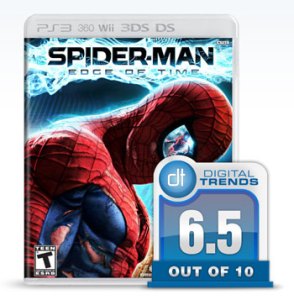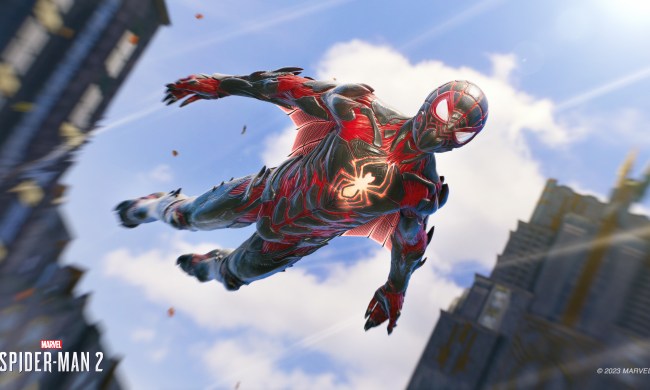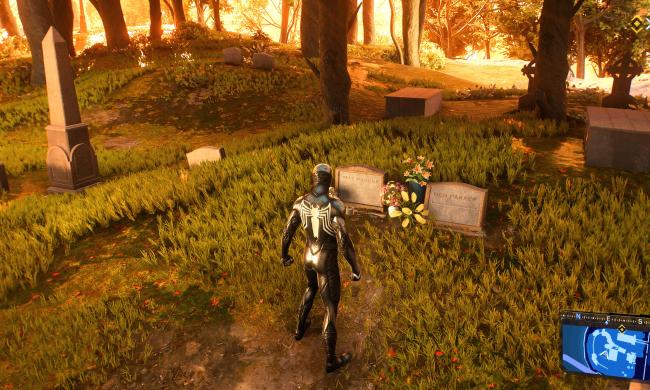 Spider-Man, Spider-Man, does whatever a generic button-mashing and flawed platformer can. Following up on last year’s Spider-Man: Shattered Dimensions, Beenox returns with a new Spider-Man title, in what now appears to be an annual-release franchise. And who can’t get enough Spidey? Of all comic book heroes, he is one of the most adapted to video games. Besides the colorful character himself, and the cornucopia of villains that he can battle, Spidey has the ability to swing from place to place, scale walls and wail on enemies with super strength and enhanced speed. What more could you ask for in a video game?
Spider-Man, Spider-Man, does whatever a generic button-mashing and flawed platformer can. Following up on last year’s Spider-Man: Shattered Dimensions, Beenox returns with a new Spider-Man title, in what now appears to be an annual-release franchise. And who can’t get enough Spidey? Of all comic book heroes, he is one of the most adapted to video games. Besides the colorful character himself, and the cornucopia of villains that he can battle, Spidey has the ability to swing from place to place, scale walls and wail on enemies with super strength and enhanced speed. What more could you ask for in a video game?
While Spider-Man: Shattered Dimensions had some problems, it had a lot of good to it too, especially for hardcore Spidey fans. It introduced four versions of Spidey, each with a slightly different gameplay style, and each with their own storylines. The gameplay was a bit repetitive, and not all the Spideys were created equally, but it had a few solid moments.

Surprisingly, Beenox doesn’t use that scenario at all. In fact, the levels are all confined, and you never once venture outside. What you do get to do, though, is fight. A lot — although maybe it just blurs together into one big, unimpressive battle. You fight the same generic enemies over and over again: Maybe they are mutants, or perhaps they are futuristic robots, but it really doesn’t matter, and along the way they seem to change with no real explanation. Along with radioactive spider strength, agility and a spidey sense, Spider-Man apparently also picked up the ability to deal with massive amounts of tedium and repetition. Good for him, bad for gamers.
While not a direct sequel, Spider-Man: Edge of Time builds on Shattered Dimensions, but it builds sideways. If anything, it takes a step back by limiting what you can do, offering less in all categories from its flawed predecessor. This Spider-Man is definitely not amazing.
Back to the future
The plot of Edge of Time plays fast and loose with details. You might expect that from a comic, and so it works to a degree in Edge of Time — at least as long as you don’t look at it too closely. The story involves time travel and alternate timelines, all revolving around the modern day Amazing Spider-Man, and Miguel O’Hara, the Spider-Man of 2099.

When Spidey 2099 learns that one of the changes will lead to the death of Peter Parker at the hands of Anti-Venom, both Spideys begin to work together to stop the CEO. The details are a bit sketchy on the how and why. For example, the two Spideys can speak to each other through a quantum thingee, and they share a temporal link that can lead to further alterations in time. Neither are ever really explained all that well, so you just need to accept that there is gameplay mechanic that allows one of the Spider-Men to do something that affects the environment of the other while they chat about it.
This mechanic isn’t something you can use, but rather part of a triggered events. As you play, you switch between the two Spideys and spend equal amounts of time in the future and the present. There is even a section where the Spideys switch time periods.
The plot is almost an afterthought to the game. There is a big reveal towards the end as to who the actual mastermind is, and it makes little to no sense. It feels tacked on, like the writers needed a twist and worked backwards from there. The story just doesn’t ever make itself felt. The majority of the missions involve you needing to find a key, or a sample, or something else, and along the way you beat up a ton of people. Rinse and repeat.

The story is designed to justify the gameplay. That would be fine if the gameplay were solid. It isn’t.
Your friendly neighborhood brawler
The thing with Spider-Man games is that there are a few things that the character should always be able to do in a game. He should be able to swing, dodge and move quickly, and they don’t call him a “wall-crawler” for nothing. Edge of Time does these things, just not very well. The swinging mechanic is essentially useless, because you are never outside. Not once. There is never a chance to swing around and have fun. If you want to move up between levels, your best bet is the zipline, which means you look at a specific point, then hit a button to quickly pull yourself up. It isn’t a very accurate system though, and when you try to do it quickly it becomes a headache.
Spidey’s other movements aren’t much better. His ability to climb on walls is essentially rendered obsolete. The only time you will crawl on the ceiling is to collect orbs and golden spiders, both of which are used for upgrading fighting moves. Where in Shattered Dimensions, there were entire sections where wall crawling added a stealth element, if you crawl on a wall and someone sees you — and they will — they will shoot you and force you to fall. Fun!
The combat is also slightly less spectacular than Shattered Dimensions, but both games do share a problem with repetition. The upgradeable moves return, as does the web of challenges — which you can go through and play separately as well. Both Spidey 2099 and Amazing Spidey have a few movements unique to them, but in general their move sets are very similar. One may use webs to pull himself to enemies, while the other may pull the enemies to him. It really isn’t a big difference, and your tactics remain the same.
Both also have a fast move. Amazing Spidey moves quickly and casts multiple images of himself while dodging, while Spidey 2099 creates decoys. They both work almost identically, though. Then there is the fighting. Light attack, light attack, light attack, heavy attack. Again and again and again. You can work in a few combos, but it is a button-masher first and foremost.

Beyond even these considerable flaws, the controls just feel sluggish at times. They are unresponsive, the dodging doesn’t offer any counterattacks, and knocking enemies down without being able to finish them (you instead have to wait for them to rise) gets old. You really feel that when you attempt the challenges. Timed events can quickly became the bane of your existence. They are painful. The fighting challenges are slightly better, but they are also inconsistent. For instance, you can cruise through some fights without being touched, yet replay that same fight and suddenly be shot 20 times by an off-camera enemy as you attempt to swing free.
Put all that aside and you hit the biggest problem: the repetition. The enemies are interchangeable and unremarkable. Although you do earn some points to use towards upgrades by defeating enemies, it becomes easier and less tedious to skip them when you can. There is no joy in the combat system, and the upgrades don’t offer much to change that. You can forgive a poor story and generic enemies if the gameplay is fun, but it isn’t. There is very little variety, which leads to boredom.
Conclusion
Edge of Time isn’t a broken game. It cracks a few good jokes, the voice-acting is actually very good, and the graphics are solid. Unfortunately, the dialog that the Spideys (Spiders? Spidi?) churn out is essentially,“But I need a key!” “Well go beat up the guard to get it!” Over and over.
The repetition is problem enough, but when paired with combat system that can best be described as “meh,” then you have a problem. Not a long problem though; the game can be beaten in seven or eight hours — less if you are determined, and the only real replay value comes from the desire to see Spidey in alternate costumes.
Spider-Man: Edge of Time is a game that feels rushed, but at least rather than releasing a broken game, Beenox released a partial one. Yay? There are only three Spidey enemies in the entire game, you never once go outside, the enemies are all the same, and the combat is uninspired. Better luck next year, true believers.
Score: 6.5 out of 10
(This game was reviewed on the PlayStation 3 on a copy provided by Activision)


